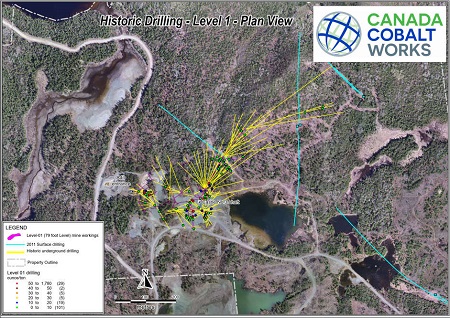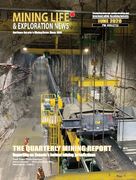Canada Cobalt Drills into Bonanza Grades at Castle Mine Near Gowganda

Canada Cobalt Works Inc. announced that Phase 1 drilling on the first level of the Castle mine near Gowganda, 75 kilometers from Kirkland Lake, has returned multiple high-grade cobalt and silver intercepts at very shallow depths.
Drill results have also revealed areas overlooked by previousl exploration programs that show potential to host very high-grade "shoots" of silver and cobalt-silver mineralization, mixed with occasional nickel and gold, that may extend to considerable depths outside of historical drilling or workings.
High Grade Silver, Cobalt and Gold
New discovery of very high-grade silver vein structures approximately 55 meters southwest of the #3 Shaft where a silver discovery in 1979 put the Castle mine back into production for a decade - CA-18-54 cut 93.7 ounces per ton Ag (3,213 grams per tonne) over one meter including 286.3 ounces per ton (9,816 g/t) over 0.33 meters starting just 9.71 meters downhole, with the hole drilled across the structure at 25o to core axis and then bottoming in high-grade mineralization from 18.84 meters to 20.50 meters; 385.2 ounces per ton silver (13,208 g/t), 0.67% cobalt and 3.77 g/t gold over half a meter within a broader 5.51-meter zone that also included 1.87% cobalt over 2.54 meters and 76.4 ounces per ton Ag (2,620 g/t) over a core length of 5.51 meters starting at just 1.46 meters (CA-18-02, collared near the adit entrance, was drilled perpendicular to the strike of the targeted vein structure, sub-parallel to the dip of the vein).
All 47 assayed shallow underground test holes intersected cobalt mineralization with an impressive one-quarter of those holes returning high-grade intercepts of 1.05% to 3.7% cobalt over an average core length of 1.77 meters (true widths unknown at this time).
A series of key initiatives, already in motion, will drive an expanded Phase 2 program to immediately build on these results and accelerate the broader 2019 corporate goal to leverage the company's proprietary Re-2OX technology simultaneously with heightened activity at the Castle mine in ways that continue to keep CCW share dilution to a minimum.
"These results from our first-ever underground drilling support the interpretation that much was left behind at the Castle mine, not just cobalt but very high-grade silver, commented Jacques Monette, Canada Cobalt Director. "This array of high-grade intercepts at shallow levels further energizes our team as we ramp up again and implement a greatly expanded second phase of our underground strategy."
"2018 was a pivotal year in the revitalization of the Castle mine," Monette continued, "and we look forward to achieving key new milestones in the coming months. At the height of winter, we have a very active site and another drill program kicking off this week southeast of the mine as we build on a potential high-grade gold discovery at Castle East. This is an exciting new development as the Archean rocks east of the high-grade silver mines were never tested historically."
Immediate priority is follow-up drilling targeting high-grade "shoots" near #3 Shaft and adit entrance.
Through discussions with Canada Cobalt's engineering consultant, and the Northern Ontario Ministry of Mines and Development, all material from the first level stopes will be dumped and removed in accordance with an amended advanced exploration permit (notably, Canada Cobalt can produce gravity concentrate on site). The stopes will then be available for back-filling with cemented tailings as part of a major new program involving Re-2OX that Canada Cobalt will be elaborating on in the very near future.
As part of the amended exploration permit, blasting will be undertaken throughout the first level. Hydrogeological studies will evaluate dewatering of the remaining 10 levels of the Castle mine.
Underground Drilling Results
Underground drilling from #3 Shaft Area drill hole CA-18-54 hit two very high-grade silver intercepts starting just 9.71 meters downhole, 93.7 opt (3,213 g/t) over one meter including 286.3 opt (9,816 g/t) over 0.33 meters, followed by 11.8 opt (406.1 g/t) over 1.66 meters at the bottom of the hole beginning at 18.84 meters. Drilling was across these structures, with the first intercept at 25o to core axis and the latter intercept cutting a new vein at a lower angle than the first intercept. This is a new discovery where there was limited previous work - follow-up drilling will track the vein, and potential associated veins, to depth.
Adit Entrance
A further review of historical work in addition to Canada Cobalt drilling including updates of previously released preliminary data, suggests a silver-cobalt rich vein intersected near the adit entrance in the first three drill holes may also extend much further to depth. CA-18-02 was one of several holes that attempted to follow the vein from a series of inclinations from approximately the same drill set-up through the Nipissing Diabase toward the second level in order to test grade potential. Veining is irregular, so contacts averaged approximately 25 degrees to core axis (refer to Nov. 2, 2018 news release).
High-Grade Cobalt Values Confirmed
For the first time at the Castle mine, high-grade cobalt values, along with occasional nickel and gold, have been confirmed through drilling to exist in vein structures, and as much as 174 meters apart (collar to collar) from near the adit entrance (23 meters below shaft collar) to the #3 Shaft area.
Multiple Target Areas Throughout Expansive First Level
Phase 1 drilling has provided the Canada Cobalt geological team with multiple highly prospective new targets for detailed follow-up utilizing a more versatile and powerful drill rig that can track high-grade veins to depth. Many vein structures have yet to be tested. Based on historical mining data, veins at Castle are known to pinch and swell and move in and out of high-grade and lower grade mineralization over considerable distances. The first level (there are 11 in total) is in excellent condition with a footprint of 365 meters east-west and 360 meters north south. A total of 58 holes were completed (47 have been assayed) in Phase 1, totaling 675 meters. A table of assay highlights/details will be posted on the Canada Cobalt web site.
Canada Cobalt Adds $500,000 From Exercise of Warrants
Canada Cobalt has received approximately $500,000 from the exercise of warrants over the past two months and will continue its Northern Ontario Cobalt Camp leading practice of keeping share dilution to a minimum while aggressively advancing its exploration and development strategies in a cost-effective manner.
Quality Assurance/Quality Control
Canada Cobalt Works' AQTK drill program employs diligent standards in drill core sampling and quality assurance/quality control. Core from the above holes was sent to Swastika Laboratories in Swastika, Ont., for analysis. Where silver was visually and significantly present, a pulp-metallic analysis was completed for the silver assays. The entire sample was dried, weighed and crushed over 95 per cent, then fully pulverized and passed through 147-micron screen to create a plus-147-micron fraction (metallics) and a minus-147-micron fraction (pulp). Approximately 50 grams of the metallic fraction was weighed, fused and assayed by fire assay. The resulting dore bead of gold and silver was weighed before adding HNO3 acid to dissolve the silver. The remaining gold bead was weighed and subtracted from the gold plus silver bead to give a silver weight and grade for the metallics portion. The minus-147 fraction (pulp) had two samples from entire pulp which were weighed and then digested by two-acid aqua regia and finalized by AAS reading for cobalt, silver and nickel. Final silver grade is a calculated weighted average using grades and weights from both pulps and metallics.
As gold was not assayed in the pulps, the final gold assay was calculated by weighted average, as for the silver, but assuming a grade of zero gram per tonne gold for the pulp portion. Cobalt and nickel were reported as a percentage grade. Other samples were assayed for cobalt, silver and nickel by AAS after aqua regia digestion. Analytical accuracy and precision are monitored by the analysis of reagent blanks and reference materials at the lab. Quality control is further assured by the insertion of blind certified standard reference material and blanks into the sample stream at regular intervals by Canada Cobalt Works personnel in order to independently assess analytical accuracy.
Canada Cobalt is a pure play cobalt company focused on its past producing Castle mine in the Northern Ontario Cobalt Camp, Canada's most prolific cobalt district. With underground access at Castle, a recently installed pilot plant to produce cobalt-rich gravity concentrates on site, and a proprietary hydrometallurgical process known as Re-2OX for the creation of technical grade cobalt sulphate as well as nickel-manganese-cobalt (NMC) formulations, Canada Cobalt is strategically positioned to become a vertically integrated North American leader in cobalt extraction and recovery.
For more information https://www.canadacobaltworks.com/

|